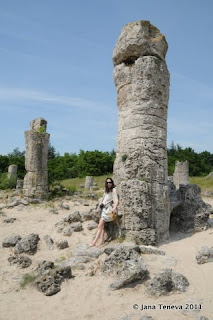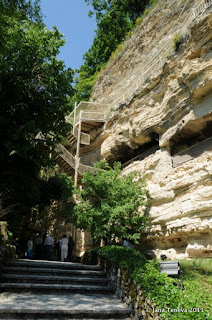
The above historical information is taken from the site http://www.bulgarianmonastery.com;
let me take you on a visual trip to some interesting places, amazing nature wonders or just magnificent moments of my life in Europe and around the rest of the world:-)

Today I will take you on a walk through the center of Varna. Varna is our marine capital and the third largest city of Bulgaria.
It is not a favourite city of mine I have to say, it is pretty busy, haotic and dirty. However in the city center there is a lot of pretty and colourful architecture in Western style with local interpretations of Neo-Renaissance, Neo-Baroque, Neoclassicism, Art Nouveau and Art Deco.
Unfortunately almost all of the beautiful buildings in the center got additionally "decorated" with huge advertisements, which i find pretty grotesk and ugly...The sea garden along the beach is the oldest and biggest park of the city.
Varna is a front-runner for European Capital of Culture for 2019, planning to open several new high-profile facilities such as a new opera house and concert hall, a new exhibition centre, and a reconstruction of the Summer Theatre, the historic venue of the International Ballet Competition.
And something with which Varna beats even Sofia....is of course the sea:-) And last but not least Varna offers a great attraction with the its dolphinarium!
Enjoy the colours, enjoy the diversity...I was blown away during my walk in the nature in the nature reserve Russenski Lom...
Beautiful beetles (such as the cetonia aurata on the third picture), colourdful dragonflies, perfectly hiding green grasshoper! Nature is breathtaking!
One of the 9 places in Bulgaria on the UNESCO heritage list are the breathtaking rock hewn churches next to the village Ivanovo. They are located in the nature reserve Russenski Lom, in the northeastern part of Bulgaria, around 22 km south from the city of Russe.
The Ivanovo Rock Churches represent a network of about 20 small rock churches, chapels and individual cells dug at a different height in the rocks of the Russenski Lom Canyon. Narrow paths of rock ladders and staircases link these premises. In the past the number of these churches was over 40, while the cells were more than 300, inhabited by monks many of whom were grammarians and men of letters. Christians in those days used to go there on something like a pilgrimage. The first hermits dug their cells in the rocks in the 12th century. The 14th century wall paintings (on the picture above and below) are a proof of the highly developed mastery characteristic of the painting school of Bulgaria’s Medieval capital of Veliko Tarnovo.
Nowadays one may visit only one church: the church of Virgin Mary. This complex has been dug into the rock at an altitude of 38 meters from the base. It is entirely covered by frescoes of biblical and scenes and images. The Last Supper is one of them, as well as the Entrance in Jerusalem, St. John the Baptist, the Passions of Christ, the portraits of the Apostles; other saints and pictures of their lives. These world-renowned wall paintings from the 14th century are some of the top achievements of Medieval Bulgarian and Balkan art. Donors to the rock monasteries were Bulgarian kings Ivan Assen II /1218-1241/, Ivan Alexander /1331-1371/ and other families of the nobility, whose portraits have been painted on the church walls and are preserved to this day. A reason while its is so well preserved is the fact that it has been discovered not so long ago, in 1937 by an Austrian archeologist.
The area around the rock cells and churches offers a very relaxing and green background for a pleasant walk in the nature too:-)

"Pobiti kamyni" are natural rock phenomenon around 17 km away from Varna, on the road to Sofia. The place consists of several groups of stone columns (between 5 and 7 metres high and from 0.3 to 3 metres thick) on a total area of 70 km². The columns are instead hollow and filled with sand, and look like they are stuck into the surrounding sands, which gives the phenomenon its name ("Pobiti kamyni" means stones put in the ground).
Several rocks have names, such as the "Throne", the "Camel" or the "Lion"...The place is believed to charge visitors with positive energy. "Pobiti kamyni" are a nature reserve since 1937.
The origin of these rocks is still not confirmed. The place was under water some 50 millions years ago. One theory says the limestone columns represents the result of coral activity. The other theory is minaral based and supposes connection to bubbling reefs.
There is no doubt, its an impressive place to visit, as well as the amazing colours in a field we also had the pleasure to admire on the way to it!
While walking around the resort "St Konstantin and Elena" at the Black sea coast I could not stop admire old the wildflowers and herbs.....The white acacia trees, the puple mallow flowers, the honeylike smelling lime-tree, the strong red colour of the poppy flowers...They are all around.
Not a lot of people are aware that the mallow (first picture, also called in de: "Malve", nl: "kaasjeskruid", bg:"камбулка") is a very famous herb, which helps heal heavy caughs.
As for the acacia blossoms, they deliver the juice for the bees and I just got a fresh jar of acacia honey the other day....
Some hotels in the resorts have some creative flower decoration such as the dolphins and the peafowl.

Aladja manastery is one of the most famous rock monasteries in the northeastern Bulgaria. This medieval rock cave monastery is located 17km north of Varna, the second biggest city of the country, which is also called the sea capital.
The monastic cells were carved in the 25-m high carst cliffs at different levels. The third picture shows how the cave complex used to look like...
Today, the grotto is a popular tourist destination. Its present name appeared in the late Ottoman period; "aladja" (which means colourful) referred to its colourful murals, now almost destroyed.
